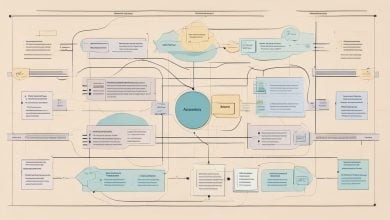
Identity management has become an increasingly critical concern in today’s digital age. From personal data breaches to online identity theft, safeguarding personal information has become a top priority for individuals and organizations alike. As such, identity management trends are constantly evolving as new technologies and innovations emerge.
The next wave of identity management innovation promises to bring forth significant changes in how we protect and manage our identities online. Predictions for the future of identity management include advancements in biometrics and multi-factor authentication, as well as more integrated identity management solutions to streamline the process for users.
Key Takeaways:
- The future of identity management promises to revolutionize how we protect and manage personal information online.
- New technologies and innovations, such as biometrics and integrated solutions, are expected to play a significant role in identity management trends.
- Ensuring the security and privacy of personal data remains a critical concern for individuals and organizations in the digital age.
Evolution of Identity Management: From Authentication to Integrated Solutions
In the early days of the internet, identity management was focused solely on authentication – verifying that a user is who they claim to be. This was typically done through passwords or security questions, which were easy to bypass or compromise.
As the digital landscape evolved, so did the need for more advanced identity management solutions. With the rise of e-commerce, mobile devices, and social media, traditional authentication methods became inadequate. Users needed a way to securely access multiple accounts and platforms from any device, without sacrificing convenience.
The future of digital identity lies in the development of integrated solutions that combine authentication, authorization, and access control to create a seamless user experience. These solutions will leverage advancements in technologies such as artificial intelligence, biometrics, and blockchain to ensure the security and privacy of personal data.
Next Generation Identity Management
Next generation identity management solutions will prioritize user convenience and accessibility, while maintaining a high level of security. For example, biometric authentication – using fingerprint, facial recognition, or voice recognition – is becoming increasingly popular due to its ease of use and high level of security.
Blockchain technology is another innovation that is being explored for identity management. With blockchain, personal data can be stored in a decentralized, secure and tamper-proof manner, eliminating the risk of data breaches.
The future of identity management is not just about keeping up with technology advancements, but also adapting to changing regulations. As laws such as the General Data Protection Regulation (GDPR) become increasingly strict, organizations will need to ensure that their identity management solutions comply with these regulations.
The evolution of identity management from simple authentication methods to integrated solutions is driven by the need for security, convenience, and compliance. The future of digital identity is bright, with endless possibilities for innovation and growth.
Security Innovations in Identity Management: Protecting Personal Data in the Digital Age
In today’s digital age, protecting personal data has become paramount. With the increasing number of cyberattacks, it is essential to adopt advanced identity management solutions that can safeguard sensitive information from unauthorized access.
One of the most promising innovations in identity management is the use of biometrics. This technology relies on unique biological characteristics, such as fingerprints, facial recognition, and iris scans, to verify identity. As biometric data is inherently personal and difficult to replicate, it provides a high level of security not possible with traditional authentication methods.
Multi-factor authentication is another vital advancement in identity management. This approach combines two or more authentication methods (such as a password and a fingerprint) to minimize the risk of unauthorized access. By using multiple factors, even if one is compromised, the others can still provide a layer of security.
Encryption is another key element in securing personal data. By encrypting data, it becomes unreadable to unauthorized users, ensuring that even if it is intercepted, it is of no use to them. Advanced encryption methods, such as quantum encryption, have the potential to revolutionize data protection in the future.
Identity management solutions for the future must incorporate these innovative technologies to provide adequate protection against emerging threats. With the increasing complexity of cyberattacks, organizations must adopt a proactive approach to security rather than a reactive one. By prioritizing identity management, they can take steps to safeguard their data and stay ahead of potential risks.
Future-proofing Identity Management: Adapting to Changing Technologies and Regulations
The digital landscape is rapidly evolving, and identity management must adapt to keep pace with these changes. Organizations must adopt solutions that are flexible, scalable, and capable of meeting new regulatory requirements. Future-proofing identity management is essential to stay resilient and competitive in the future.
Flexibility and Scalability
Identity management solutions must be flexible and scalable to adapt to changing technologies and regulations. The ability to integrate emerging technologies and comply with new regulations is critical. Organizations should consider cloud-based solutions that offer scalability and the ability to customize features as needed.
New Regulations
New regulations, such as the General Data Protection Regulation (GDPR) and the California Consumer Privacy Act (CCPA), require organizations to implement strong data protection measures. Identity management solutions must comply with these regulations and offer robust data protection features.
User Experience
User experience is also a critical factor in future-proofing identity management. Solutions that offer a seamless user experience and minimize friction while maintaining security are essential. Multi-factor authentication methods, such as push notifications and biometrics, provide enhanced security without sacrificing usability.
Adopting Emerging Technologies
Identity management solutions must also be capable of integrating emerging technologies, such as blockchain and artificial intelligence. These technologies offer new opportunities for enhancing security and improving the user experience. Organizations should consider solutions that take advantage of these emerging technologies to stay ahead of the curve.
Future-proofing identity management requires an ongoing commitment to innovation and a willingness to adapt to change. By adopting flexible and scalable solutions, complying with new regulations, prioritizing user experience, and adopting emerging technologies, organizations can stay resilient and competitive in the ever-changing digital landscape.
Conclusion
As we look into the future of identity management, it’s clear that innovation is the key to staying ahead of the curve. With the evolution of digital identity and the increasing threats to personal data, organizations must adapt to the changing landscape by implementing advanced solutions that prioritize security while providing a seamless user experience.
From the emergence of integrated identity management solutions to the development of cutting-edge authentication techniques like biometrics and multi-factor authentication, the future of identity management is full of exciting possibilities.
However, in order to future-proof identity management, it’s essential to remain flexible and scalable, and to prioritize the development of solutions that can adapt to changing technologies and regulations. By doing so, organizations can stay resilient and competitive in the years to come.
Ultimately, identity management will play a crucial role in driving innovation and ensuring security in the digital realm. As such, it’s more important than ever to prioritize identity management and to stay ahead of the curve in this rapidly evolving field.
FAQ
Q: What is identity management?
A: Identity management is the process of managing and controlling digital identities, which includes aspects such as user authentication, access management, and data protection.
Q: Why is identity management important?
A: Identity management is important because it helps organizations ensure the security of their systems, protect sensitive data, and control access to resources. It also plays a crucial role in complying with regulations and maintaining user trust.
Q: What are the current trends in identity management?
A: Some of the current trends in identity management include the adoption of cloud-based solutions, the use of biometrics for authentication, and the integration of identity management with other security systems.
Q: How does identity management address security challenges?
A: Identity management addresses security challenges by implementing robust authentication methods, such as multi-factor authentication and biometrics, and by implementing encryption and data protection measures to safeguard personal information.
Q: How can organizations future-proof their identity management?
A: To future-proof identity management, organizations should prioritize flexibility and scalability in their solutions, stay updated on emerging technologies and regulations, and regularly assess and update their identity management strategies.








